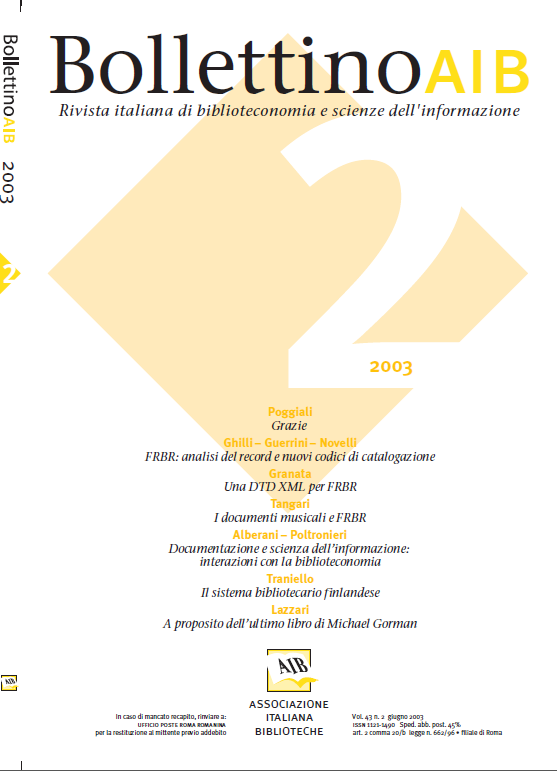Musical documents and FRBR
Main Article Content
Abstract
The publication in 1998 of the IFLA report entitled Functional requirements for bibliographic records excited considerable international interest in the world of documentation and biblioteconomy. Italy too made its mark through the attention that it gave to this report, in the first place due to the publication of its first translation into a foreign language edited by ICCU and secondly due to the publication of a series of critical interventions by individual scholars, as well as by the Study Group on cataloguing of the Italian Libraries Association.
By referring to these specific studies for an exhaustive treatise on the principles and analyses proposed by FRBR, we note how this report also appears particularly interesting from the point of view of musical documents, because it introduces a conceptual outline which can be used as a base for a theoretical reflection on cataloguing music in its many forms of expression and diffusion.
In this intervention we seek to outline the position that musical documents assume within the framework suggested by FRBR, emphasizing some aspects that in our opinion have not yet been sufficiently contemplated and confirming how the structure proposed by FRBR could give origin to some very interesting developments for the entire field of musical documentation.
FRBR is an example that is not only important for the traditional fields of biblioteconomy and library cataloguing and connected matters, but also provides a valid model for a general reflection on the cataloguing of other types of musical documents.
We believe for example that this guideline could be the base for starting a discussion and theoretical investigation into the cataloguing of musical instruments, subjects pertaining to theatrical performances, iconographic-musical documents. This, of course, quite apart form the specific description methods that are or will be applied.
For this reason, we believe that FRBR can be developed, can go beyond the area of library and similar material for which it was prepared and to which it still seems to be too closely bound, and include many other types of documents in its general plan. All this can be done with a view to an idea of documentation that is increasingly more suited to contain the greatest possible number of types of documents, but above all capable of exploiting the network of relationships between information and individual documentary items.
By referring to these specific studies for an exhaustive treatise on the principles and analyses proposed by FRBR, we note how this report also appears particularly interesting from the point of view of musical documents, because it introduces a conceptual outline which can be used as a base for a theoretical reflection on cataloguing music in its many forms of expression and diffusion.
In this intervention we seek to outline the position that musical documents assume within the framework suggested by FRBR, emphasizing some aspects that in our opinion have not yet been sufficiently contemplated and confirming how the structure proposed by FRBR could give origin to some very interesting developments for the entire field of musical documentation.
FRBR is an example that is not only important for the traditional fields of biblioteconomy and library cataloguing and connected matters, but also provides a valid model for a general reflection on the cataloguing of other types of musical documents.
We believe for example that this guideline could be the base for starting a discussion and theoretical investigation into the cataloguing of musical instruments, subjects pertaining to theatrical performances, iconographic-musical documents. This, of course, quite apart form the specific description methods that are or will be applied.
For this reason, we believe that FRBR can be developed, can go beyond the area of library and similar material for which it was prepared and to which it still seems to be too closely bound, and include many other types of documents in its general plan. All this can be done with a view to an idea of documentation that is increasingly more suited to contain the greatest possible number of types of documents, but above all capable of exploiting the network of relationships between information and individual documentary items.
Article Details
Section
Articles

This work is licensed under a Creative Commons Attribution-ShareAlike 4.0 International License.
